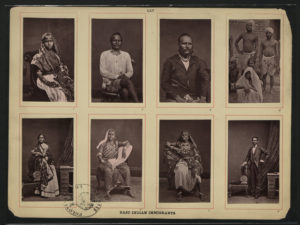By the time East Indian indentured labourers arrived in British Guiana in the 19th century, Indian fashion had already begun to be influenced by the-then British rulers of India.
 According to fashion historian Toolika Gupta, writing for the BBC News, the outward propriety of Victorian England,uncomfortable with the bare-breasted look of Hindu women in their saris of earlier times, led to a blouse being worn underneath, though in southern India, even in colonial times, some did not cover their upper body.
According to fashion historian Toolika Gupta, writing for the BBC News, the outward propriety of Victorian England,uncomfortable with the bare-breasted look of Hindu women in their saris of earlier times, led to a blouse being worn underneath, though in southern India, even in colonial times, some did not cover their upper body.
In fact, she writes, it was the wife of Satyendranath Tagore (the famous Indian poet Rabindranath Tagore’s brother) who popularised the modern sari [with its draping and inner piece, called a “choli” or “ravika”], after she was reportedly refused entry to clubs for wearing the sari fabric over her breasts.
It is this British enforced design and draping that remains an emblem of Indian sari culture both in the north and south of India today,which was brought over to British Guiana during indentureship.
It would be hard to imagine the British freely allowing women without the undershirt of their sari to make the journey and arrive in British Guiana in such ‘impropriety’.
Anglicizing, which included discarding the caste system by rounding up all women, children and men regardless of caste, had begun from the time they arrived at the British Guiana immigration depot at Garden Reach, Kolkata.
Gupta observes also that, “At the height of the Victorian era the British and Indian fashions rather resemble each other…”
 It would not be long after, with the Christianisation of many Hindus and Muslims, that many other British Guiana indentured immigrants began wearing western/British clothing altogether.
It would not be long after, with the Christianisation of many Hindus and Muslims, that many other British Guiana indentured immigrants began wearing western/British clothing altogether.
Among Indian men, the dhoti was at the time the traditional mode of dress. About four to six feet long, white or in colour, the dhoti was worn long or short.

It was worn for centuries among Indian men, with many regional variations. In the southern part of India, men would pull up the dhoti and pleat the top around the waist, where it ended just below the knees.
Among the Muslims, it was the influence of the 16th and 17th century Mughal empire that “gave birth to garments like the salwar kameez ” today, Gupta notes, as Muslim women covered themselves and often wore divided garments.
The salwar kameez also spelled shalwar kameez has also become emblematic of India, especially the North of India, in the region of Punjab where it is known also as the “Punjabi suit”.
The word salwar (or shalwar) is said to come from the Persian word for “pants”, while the kameez may have derived from the Latin word camisia, which in turn became Arabic qamīs (Urdu kamis) then “chemise” in English.
The salwar kameez also comes with the dupatta (often loosely worn scarf or shawl) which today, Hindu women view either as necessary to cover their heads when at a temple or among elders, or simply a fashion accessory. Muslim women may wear their hijab with the outfit.
There are several kinds of salwar kameez: the traditional salwar kameez is the baggy style pants and full sleeve tunic, while the Churidar salwar kameez is more shape-fitting in the legs, with an ankle closing and a longer length to create a “spiral shape look” at the bottom.

The Patiala salwar kameez began as a male garment for the Patiala maharaja but was later copied by women. It is similar to the traditional outfit but with more pleats and a “big fall” at the back.
The other type of salwar kameez is called the Anarkali, which for women, is a kurti or kurta (a loose fitting dress, shirt or tunic that falls just above or somewhere below the knee) worn with the slim fitting spiral-bottomed pants of the Churidar.
In older times, kurtas were first designed for men to wear with pyjamas (a loose trouser tied at the waist) and kurtis were designed for women to wear with loose pants. Nowadays ladies also wear kurtas.
Today, the kurta is considered longer, and usually falls below the knees, while the kurti is short, the length ranging from below the waist to the thigh.
Guyanese Hindus and Muslims especially, have continued wearing these traditional fashions over the centuries, while also taking their cue from international contemporary Hindu and Muslim fashions. (Guyana Times Sunday Magazine)



